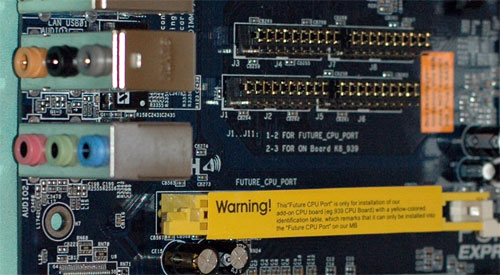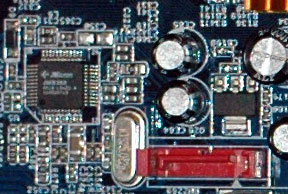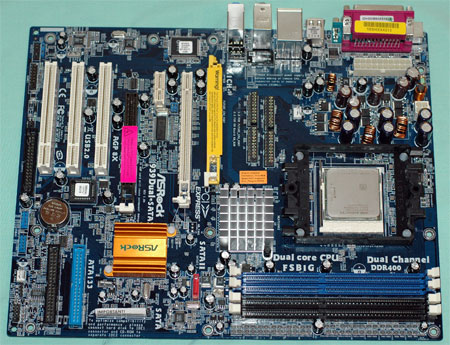ASRock 939Dual-SATA2: First Retail ULi PCIe/AGP
by Wesley Fink on September 7, 2005 12:05 AM EST- Posted in
- Motherboards
Board Layout: ASRock 939Dual-Sata2



The 20-pin (not 24-pin) ATX connector and 4-pin 12v connector are located between the CPU socket and the IO ports on this 3-phase board. This is not the most ideal location, but with both connectors near the board edge, it works well.

Value boards often present challenges in board layout to the end-user. Since the selling price is usually of foremost importance, the layout is often geared to efficient manufacturing more than end-user convenience.
The ASRock 939Dual-SATA2 is generally well laid out. Some thought clearly went into connector placement, but there are a few glaring oversights. The floppy and IDE connectors were hard to work with in a mid-tower case in light of their bottom right location. A standard IDE cable would barely make it from a top-mounted optical drive to IDE2. The floppy at the center bottom is particularly troublesome if you still use a floppy drive. If you don't, then it's a moot point.
You can clearly see the Asus heritage in the fact that ASRock uses only passive heatsinks on the 939Dual. Certainly, this is the best solution where noise is a concern, but it does not always provide for the most efficient cooling. Our experience during testing and overclocking the ASRock was that the Northbridge became pretty warm, but not warm enough to cause a shutdown or reboot.











56 Comments
View All Comments
Furen - Wednesday, September 7, 2005 - link
Well, there are no master cards to test this on but I think HKPC did this and it worked ok (with a hacked driver, most likely). Performance wasnt that hot, though.murak - Wednesday, September 7, 2005 - link
I have had this mobo for like 2 days and I am VERY happy with it! It was the only way for my unlocked 6800LE to come along to the 939 platform (and not be crippled in the process) Currently running my 3200+ @ 10x240=2400mhz 1.45v wich was way more than I expected. Corsair XL @ 2-2-2-5 (will change the last to 10, tnx Anandtech!) dualchannel @ "High" memvolt.I have flashed the new 1.20 BIOS and have had NO stability issues (as with my last Asrock board, a K7S8X) Time will tell if the quality is good enough. 7.1 surround and SATA II with NRQ is a nice bonus for me wich I will use in time.
At this time I can´t see a better "bang-per-buck"-board. Nice one Asrock/ULi!
WT - Wednesday, September 7, 2005 - link
Thanks for the detailed post, Wes ! It stands to reason that any vendor that wants to stay in business will 'follow the leader' and use those same optimized enhancements to make their product a better buy. Like you said, no one had heard of DFI 3 years ago, and Abit and Asus were everyones top choice. With bad news from the Abit camp lately, I would not be surprised to see them fold like a bad poker hand. I wouldn't <i>LIKE</i> it, but this is a tough industry to make a go of it too. I'm currently happy as a clam with my Soltek NF3 board, but this Asrock board is my #1 choice when my next upgrade comes along.FriedRiceBob - Wednesday, September 7, 2005 - link
I liked this article, this is type of board that I'm contemplating for an upgrade.However, I would like to see, for a more fully rounded comparison, a benchmark of an equivalent NF3 939 AGP system, and maybe a KT800, included in the results. Am I the only one that seems to think that inlcuding a multitude (6 actually) of similarly (within 2fps) performing NF4 boards to be bordering on pointless?
I know that NF4 is the current de-facto standard, but it would be interresting to have these other results included.
KayKay - Wednesday, September 7, 2005 - link
How is it that every motherboard reviewed since the beginning of this year seems to have better and better overclocking results? i just find it hard to believe that boards from sapphire, jetway and ASRock seem to outperform boards from EPox DFI etcetc.Wesley Fink - Wednesday, September 7, 2005 - link
We are told by industry analysts the DFI nForce4 boards are now the top seller among all Socket 939 boards. Since no one had heard of DFI 2 or 3 years ago in the AMD market, other manufacturers have been paying attention to what got DFI to this sales level. There are many clever overclocking tricks used on the DFI boards and we are told other mfgs have been x-raying the board and trying to do even better in performance in their new chipsets and boards.ATI had a pretty basic Rx480 motherboard in August 04, but they devoted a whole development team at targeting the enthusiast. We suspect that Jetway, ULi and other recent great overclockers did not get to these OC levels by accident.
Furen - Wednesday, September 7, 2005 - link
Well, AMD's integrated northbridge seems to help out a lot since chipset manufacturers dont have to deal with the mem controller. Also, most of the new chipsets have been aimed at the "enthusiast" market so of course they all overclock better than the old via chipsets.Tetsuro - Wednesday, September 7, 2005 - link
For those that like this board so much, one bad bios flash and bye-bye mobo...Asrock doesn't support bios boot block recovery. They use 2 phase power regulators instead of the industry standard of 3 and there is no voltage adjustment regardless of what is claimed. Asrock cuts alot of corners resulting in horrible quality mobos. Even ECS is a lot better lately.Wesley Fink - Wednesday, September 7, 2005 - link
As we reported in the review, this board is 3-phase and not 2-phase as you state. Please look carefully at the board pictures.There is no doubt ASRock is a value brand built down to a price point, and that means corners are cut. However, the value component is sometimes a much cheaper chipset. We report what we find in our tests, and you are certainly right to point out the potential downsides of buying a value motherboard.
Calin - Wednesday, September 7, 2005 - link
The board might be value in everything, but certainly isn't in performance. And the fact that it overclocks so well could suggest it is thought out well, and that stability (at least for the board brand new) is not at all a problem